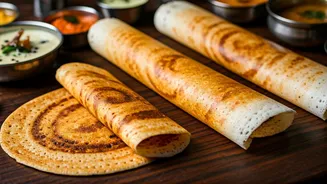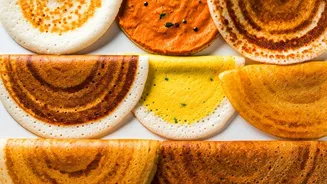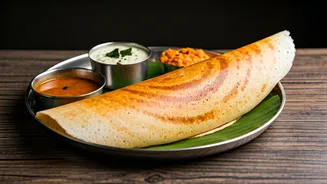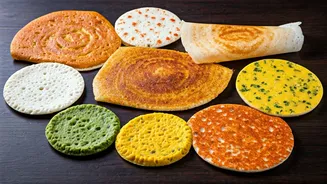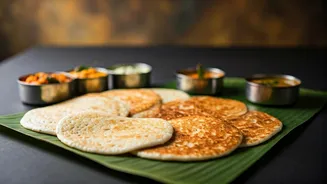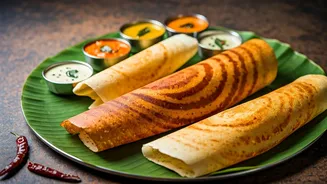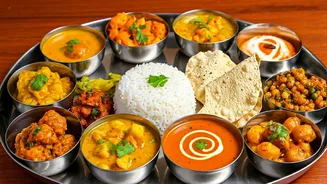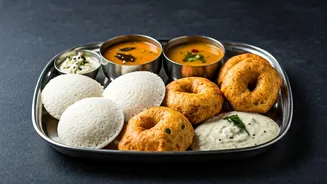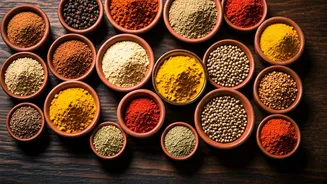Introduction to Dosas
South Indian cuisine boasts a rich heritage, and dosas are undoubtedly one of its most celebrated components. These thin, crispy pancakes, made primarily
from fermented rice and lentil batter, are a staple across South Indian households and restaurants. The beauty of dosas lies in their versatility. They can be enjoyed plain, or they can be combined with various fillings, each offering a unique burst of flavor. Dosas' adaptability is further enhanced by their ability to pair with numerous accompaniments such as sambar, chutneys, and podi. They are an accessible and wholesome option, suitable for both everyday meals and festive occasions. The preparation of dosas, though seemingly simple, requires the correct proportions and fermentation time, which enhances their taste and texture.
Masala Dosa: Classic Choice
The Masala Dosa reigns supreme as a beloved classic. It presents a thin, crispy crepe made from a fermented batter, often served with a spiced potato filling known as 'masala.' The dosa itself is renowned for its delicate texture, a product of the careful fermentation of rice and lentils, as well as the cooking method. The masala filling typically comprises mashed potatoes tempered with mustard seeds, curry leaves, onions, and spices, imparting a flavorful balance. Often, the dish is served with sambar, a lentil-based vegetable stew, and coconut chutney, creating a complete and satisfying meal. The harmonious blend of textures and tastes, from the crispness of the dosa to the soft filling and tangy chutneys, makes the Masala Dosa an unmatched choice.
Plain Dosa: Simplistic Elegance
The Plain Dosa, as its name suggests, is a simpler version of its counterparts, devoid of any filling. It showcases the fundamental qualities of a good dosa: a thin, crisp exterior, and a slightly soft interior. The absence of additional ingredients allows the flavor of the fermented batter to shine through. The preparation of the Plain Dosa involves spreading the batter thinly on a hot griddle and cooking it until it achieves a golden brown color. This dosa is typically served with an assortment of chutneys and sambar. Its simplicity makes it a versatile option, ideal for both casual and formal dining settings. Moreover, the Plain Dosa is a perfect canvas for experimenting with different accompaniments, catering to individual taste preferences.
Rava Dosa: Semolina Delight
Rava Dosa distinguishes itself from other dosa varieties through its use of semolina or rava, which provides a unique, crispy texture. The batter for Rava Dosa typically comprises semolina, rice flour, all-purpose flour, and spices. The key to its crispness is the thin, lacy consistency of the batter when it's spread on the griddle. Unlike the traditional dosa, the batter is not fermented, making it a quicker option. Rava Dosa’s flavor and texture set it apart, making it a favorite for many. The light and airy quality of Rava Dosa, along with its savory taste, make it an excellent choice for a quick breakfast or snack. It's often served with coconut chutney, sambar, and a tangy tomato chutney, which complement its flavor profile.
Paper Dosa: Super Crispy
Paper Dosa is a variation of the plain dosa, renowned for its incredibly thin and crisp texture. The batter preparation is essentially similar to a regular dosa, but the batter is spread very thinly on the griddle to achieve maximum crispiness. The result is a large, paper-thin crepe that's often served folded or rolled. Due to its size and delicate nature, Paper Dosa is frequently served plain, allowing the diners to fully appreciate its texture. It is often paired with a variety of chutneys and sambar, enhancing the overall dining experience. The experience of enjoying a Paper Dosa is a unique blend of textures, where the crispiness shatters with each bite, creating a delightful sensation.
Onion Dosa: Aromatic Flavor
Onion Dosa incorporates finely chopped onions into the dosa batter or sprinkled on top during the cooking process. This adds a subtle sweetness and a distinct aroma to the dosa. Preparing an Onion Dosa involves spreading the batter on a hot griddle, then distributing the chopped onions evenly. The onions caramelize slightly as the dosa cooks, enhancing their flavor and contributing to the overall taste profile. Onion Dosas pair well with coconut chutney and sambar. The addition of onions elevates the dosa, providing both flavor and texture. It's a popular choice for those who enjoy the savory taste of onions in their breakfast. The cooking of the onions brings out a certain sweetness that blends harmoniously with the fermented batter.
Uttapam: Thick and Savory
Uttapam diverges from the thin, crisp dosas. It is a thicker, pancake-like dosa, often studded with toppings. The batter is similar to dosa batter but has a slightly thicker consistency. Once spread on a hot griddle, toppings like onions, tomatoes, and chilies are added, which are pressed gently into the batter. This results in a soft, savory pancake with a variety of textures and flavors. Uttapam is a complete meal in itself, and it is usually served with sambar and chutneys. It’s an accessible and substantial option that contrasts with the thinness of a regular dosa, and it appeals to those who enjoy a more filling meal. The toppings contribute to its visual appeal and add to the overall taste.
Set Dosa: Soft Delight
Set Dosa is a smaller, softer dosa variety typically served as a set of two or three. The batter used for Set Dosa is similar to the standard dosa batter, but it is prepared to a slightly thicker consistency. The result is a soft, spongy texture. Set Dosas are cooked in batches, and are usually served with a generous amount of sambar and chutney. The softness of the Set Dosa makes it easier to eat and ideal for those who prefer a less crispy option. This dosa is a popular breakfast choice, and it provides a satisfying and comforting experience. The combination of soft dosas with flavorful accompaniments creates a balanced and delicious meal.
Ghee Roast Dosa: Buttery Goodness
Ghee Roast Dosa takes the flavors up a notch by using ghee, or clarified butter, during the cooking process. The batter is prepared similarly to a plain dosa. However, as the dosa cooks on the griddle, generous amounts of ghee are added. The ghee permeates the dosa, creating a golden, crispy exterior and a rich, buttery flavor. The addition of ghee brings a delicious richness that differentiates this dosa from other varieties. Ghee Roast Dosas are often served with sambar and chutneys, to balance the richness. The overall taste and texture make it a popular treat, especially for special occasions. It's often accompanied by a spiced potato masala filling, adding a further layer of flavor.
